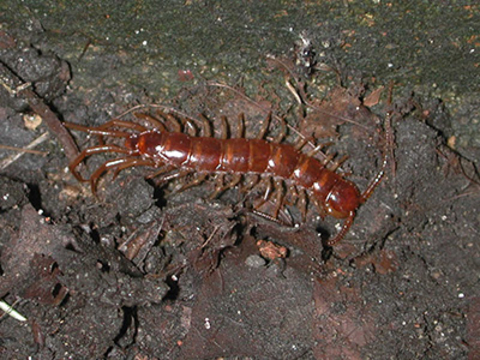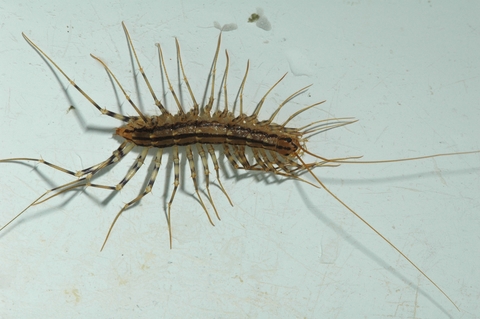Quick facts
- Sowbugs, millipedes and centipedes are not true insects but are arthropods related to insects.
- They are not harmful to people, food, clothes, furniture, or other items within homes.
- They are found in moist, decaying leaf litter or other organic material around building foundations.
- Outdoors, they are beneficial as they feed on other insects and recycle decaying organic matter.
- Tolerate sowbugs, millipedes and centipedes when possible.
- Even if they are numerous, use pesticides only if none of the other methods work to control them.
Identification
Sowbugs
The sowbug is related to lobsters, crabs and crayfish.
- It is brownish-gray and may be 3/4 inches long.
- It has fourteen legs, an oval shape and overlapping plates on its backs.
- It feeds on decaying organic matter.
- The sowbug can survive only in damp places.
Sowbugs do not normally survive within a home because they need decaying organic matter in a damp location, like a basement.
Millipedes
The millipede is a dark brown, worm-like creature with up to 400 very short legs.
- 2 pairs of legs per body segment
- Moves slowly.
- 1 to 1 ½ inches long.
- Curls up tightly when touched/handled, or after it dies.
- Feeds on decaying organic matter.
Millipedes are most active at night and hide beneath objects where it is dark and damp.
Centipedes
The most common centipede is called the house centipede.
- More than 1 inch long fully grown.
- Flattened brownish or grayish-yellow body.
- Sometimes marked with three dark stripes.
- 15 pairs of long, jointed legs that are striped.
- 2 long slender feelers extend from the head.
Stone centipede
They are found under mulch, leaves, loose bark, stones and similar sites.
- Up to 2 inches long
- Feed on insects, spiders, and other arthropods (like sowbugs and millipedes) that live in the ground on the soil surface.
- Harmless to people.
Behaviors
Sowbugs and millipedes
They crawl into homes from the soil and leaf litter, during late summer and fall and occasionally during spring and summer.
- In the fall, millipedes and sowbugs seek protected places to overwinter.
- If there is excessive rainfall or ground moisture, they may look for areas with less moisture.
- Enter through cracks in foundations, around ground-level windows and under doors.
- Commonly found in basements.
- Rarely seen indoors during winter.
- Found indoors in early spring as they emerge from cracks and crevices where they spent the winter.
Centipedes
- Found in damp conditions and seen inside homes in warm weather.
- They move indoors during spring and summer and are rarely seen in winter.
- Move quickly and are usually noticed running across a wall, ceiling or open room toward a dark area.
- May stop abruptly and remain motionless before they suddenly begin running again.
Centipedes are beneficial predators
- Feed on small, living creatures such as insects, spiders and other arthropods, like sowbugs and millipedes.
- Use poison-filled jaws to subdue their prey.
Centipede bites
Bites by a centipede are rare because it is very shy and the jaws are too small to break through human skin. If you are bitten you may see some swelling, but the pain should not be severe.
Control
Outdoors
Make conditions outside your home unfavorable for sowbugs, millipedes and centipedes.
- Seal cracks in exterior walls and around doors and windows by late summer.
- Remove leaf litter and decaying vegetation from around the foundation.
- Maintain a border of bare soil around the building next to the foundation.
- Trim and thin foundation planting so that the soil can dry more quickly.
- Allow the soil near the house to dry between waterings.
Indoors
Sowbugs and millipedes often die quickly inside homes. If sowbugs or millipedes are frequently found alive, it means there is excess moisture indoors.
- Remove sowbugs and millipedes with a broom or vacuum cleaner.
- Set out sticky traps where centipedes are seen. Kill and remove them, when needed.
- Remove unnecessary boxes, bags and other clutter.
- Seal behind baseboards and in cracks and crevices where centipedes like to hide.
- Place a dehumidifier in damp areas to dry the air.
- Structural repairs may be necessary to the home or yard to ensure dryness.
If you see numerous house centipedes, it means there are other insects in the home for them to feed on.
- Keep the number of insects, spiders and other prey under control.
- Maintain low moisture to reduce centipede numbers.
Using pesticides
Try non-chemical control methods before using pesticides.
Outdoors
- Apply a liquid pesticide around the building’s foundation in a band to help keep pests out.
- Common pesticides available for treating building foundations include bifenthrin, cyfluthrin, deltamethrin and permathrin.
- You can apply a granular pesticide to the perimeter, such as deltamethrin, lambda-cyhalothrin or permethrin.
- Apply in late summer or early fall.
- Treatment will be less effective if sites for food and shelter exist near the foundation.
Indoors
- Sowbugs and millipedes often die soon after entering homes and do not need to be treated with pesticides.
- Treat centipedes with an appropriate pesticide behind baseboards and in cracks and spaces. Pesticides are not effective if there is excessive moisture and a food supply.
- Common examples of pesticides for indoor use include bifenthrin, cyfluthrin, deltamethrin, esfenvalerate and permethrin.
- These pesticides are available in ready-to-use aerosol or liquid forms.
CAUTION: Mention of a pesticide or use of a pesticide label is for educational purposes only. Always follow the pesticide label directions attached to the pesticide container you are using. Be sure that the area you wish to treat is listed on the label of the pesticide you intend to use. Remember, the label is the law.
Reviewed in 2024





